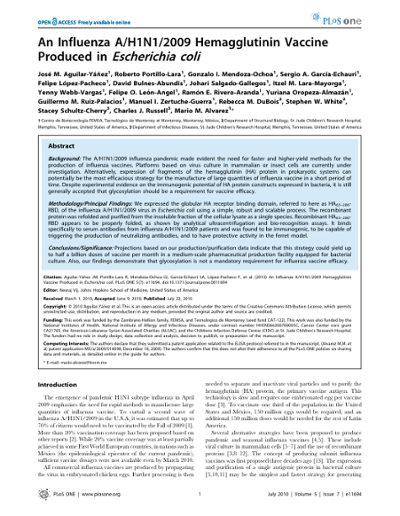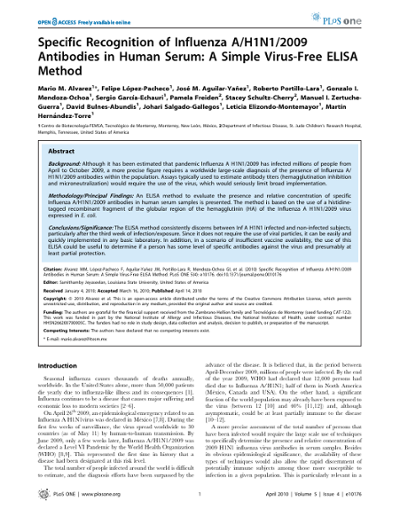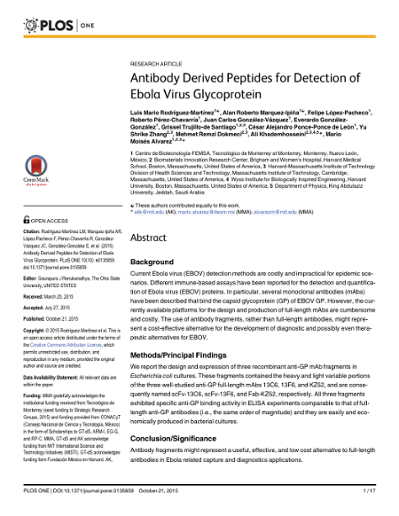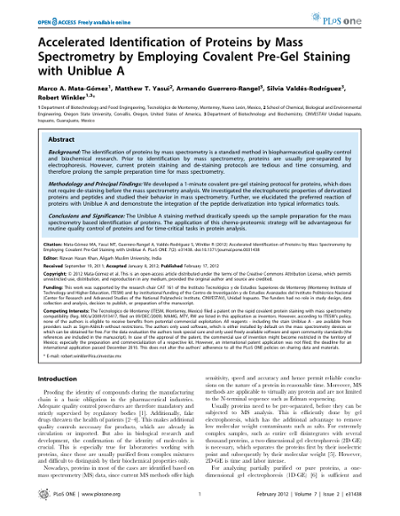| dc.creator | Roberto Portillo Lara | |
| dc.creator | José Manuel Aguilar Yáñez | |
| dc.creator | María Yuriana Oropeza Almazán | |
| dc.creator | Mario Moisés Alvarez | |
| dc.date | 2010 | |
| dc.date.accessioned | 2018-10-18T19:54:16Z | |
| dc.date.available | 2018-10-18T19:54:16Z | |
| dc.identifier.issn | 19326203 | |
| dc.identifier.doi | 10.1371/journal.pone.0011694 | |
| dc.identifier.uri | http://hdl.handle.net/11285/630272 | |
| dc.description | Background: The A/H1N1/2009 influenza pandemic made evident the need for faster and higher-yield methods for the production of influenza vaccines. Platforms based on virus culture in mammalian or insect cells are currently under investigation. Alternatively, expression of fragments of the hemagglutinin (HA) protein in prokaryotic systems can potentially be the most efficacious strategy for the manufacture of large quantities of influenza vaccine in a short period of time. Despite experimental evidence on the immunogenic potential of HA protein constructs expressed in bacteria, it is still generally accepted that glycosylation should be a requirement for vaccine efficacy. Methodology/Principal Findings: We expressed the globular HA receptor binding domain, referred to here as HA63-286 - RBD, of the influenza A/H1N1/2009 virus in Escherichia coli using a simple, robust and scalable process. The recombinant protein was refolded and purified from the insoluble fraction of the cellular lysate as a single species. Recombinant HA63-286 - RBD appears to be properly folded, as shown by analytical ultracentrifugation and bio-recognition assays. It binds specifically to serum antibodies from influenza A/H1N1/2009 patients and was found to be immunogenic, to be capable of triggering the production of neutralizing antibodies, and to have protective activity in the ferret model. Conclusions/Significance: Projections based on our production/purification data indicate that this strategy could yield up to half a billion doses of vaccine per month in a medium-scale pharmaceutical production facility equipped for bacterial culture. Also, our findings demonstrate that glycosylation is not a mandatory requirement for influenza vaccine efficacy. © 2010 Aguilar-Yáñez et al. | |
| dc.language | eng | |
| dc.relation | https://www.scopus.com/inward/record.uri?eid=2-s2.0-77955355550&doi=10.1371%2fjournal.pone.0011694&partnerID=40&md5=6d4152cd09420eef92edd06ca7213a07 | |
| dc.relation | Investigadores | |
| dc.relation | Estudiantes | |
| dc.rights | info:eu-repo/semantics/openAccess | |
| dc.rights.uri | http://creativecommons.org/licenses/by-nc-nd/4.0 | |
| dc.source | PLoS ONE | |
| dc.subject | hemagglutinin 63-286 | |
| dc.subject | influenza vaccine | |
| dc.subject | Influenza virus hemagglutinin | |
| dc.subject | neutralizing antibody | |
| dc.subject | recombinant protein | |
| dc.subject | unclassified drug | |
| dc.subject | influenza vaccine | |
| dc.subject | virus antibody | |
| dc.subject | virus hemagglutinin | |
| dc.subject | animal cell | |
| dc.subject | animal experiment | |
| dc.subject | animal model | |
| dc.subject | antibody production | |
| dc.subject | antigen binding | |
| dc.subject | article | |
| dc.subject | bioassay | |
| dc.subject | cell lysate | |
| dc.subject | controlled study | |
| dc.subject | dose response | |
| dc.subject | drug binding | |
| dc.subject | drug dose comparison | |
| dc.subject | drug purification | |
| dc.subject | Escherichia coli | |
| dc.subject | ferret | |
| dc.subject | human | |
| dc.subject | immunogenicity | |
| dc.subject | influenza A (H1N1) | |
| dc.subject | Influenza virus A H1N1 | |
| dc.subject | molecular recognition | |
| dc.subject | nonhuman | |
| dc.subject | nucleotide sequence | |
| dc.subject | protein expression | |
| dc.subject | protein folding | |
| dc.subject | protein purification | |
| dc.subject | single drug dose | |
| dc.subject | ultracentrifugation | |
| dc.subject | vaccine production | |
| dc.subject | animal | |
| dc.subject | blood | |
| dc.subject | chemistry | |
| dc.subject | enzyme linked immunosorbent assay | |
| dc.subject | Escherichia coli | |
| dc.subject | genetics | |
| dc.subject | immunology | |
| dc.subject | Influenza virus A H1N1 | |
| dc.subject | metabolism | |
| dc.subject | reverse transcription polymerase chain reaction | |
| dc.subject | Adolescent | |
| dc.subject | Adult | |
| dc.subject | Aged | |
| dc.subject | Aged, 80 and over | |
| dc.subject | Antibodies, Viral | |
| dc.subject | Australia | |
| dc.subject | Child | |
| dc.subject | Child, Preschool | |
| dc.subject | Cohort Studies | |
| dc.subject | Humans | |
| dc.subject | Influenza A Virus, H1N1 Subtype | |
| dc.subject | Influenza, Human | |
| dc.subject | Male | |
| dc.subject | Middle Aged | |
| dc.subject | Pandemics | |
| dc.subject | Seasons | |
| dc.subject | Young Adult | |
| dc.subject | Animals | |
| dc.subject | Antibodies, Viral | |
| dc.subject | Enzyme-Linked Immunosorbent Assay | |
| dc.subject | Escherichia coli | |
| dc.subject | Ferrets | |
| dc.subject | Hemagglutinins, Viral | |
| dc.subject | Influenza A Virus, H1N1 Subtype | |
| dc.subject | Influenza Vaccines | |
| dc.subject | Protein Folding | |
| dc.subject | Reverse Transcriptase Polymerase Chain Reaction | |
| dc.subject | Bacteria (microorganisms) | |
| dc.subject | Escherichia coli | |
| dc.subject | Hexapoda | |
| dc.subject | Mammalia | |
| dc.subject | Mustela | |
| dc.subject | Prokaryota | |
| dc.subject.classification | 7 INGENIERÍA Y TECNOLOGÍA | |
| dc.title | An Influenza A/H1N1/2009 hemagglutinin vaccine produced in Escherichia coli | |
| dc.type | Artículo | |
| dc.identifier.volume | 5 | |
| dc.identifier.issue | 7 | |
| refterms.dateFOA | 2018-10-18T19:54:16Z | |




